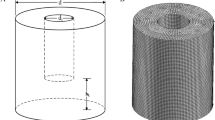In contrast with microbial systems, no research has addressed the initial stages of mammalian cell transport and adsorption to anin vitro substratum as a function of growth and fluid flow conditions. (J.D.Bryers. 1990)
Abstract
The use of internal rotating sieves for perfused hybridoma culture offers unique advantages but has been up to now largely empirical. Calculations have been performed on a 15 1 spinfilter stirred tank in order to have an idea of hydrodynamic conditions inside and outside the rotating sieve. The large peripheral velocity value, resulting from sieve rotation (compared to axial and radial velocities) is expected to affect strongly sieve surface colonization by cells; this is confirmed by lab scale experiments, showing that cell colonization is prevented providing sieve rotation exceeds a defined value (around 0.6 m.s1 tip speed); the fluid removal force calculated under these conditions appears to be in the range of 10 pN, similar to the adhesion force already reported for mammalian cells attached to inorganic substrata.
Similar content being viewed by others
Abbreviations
- A:
-
filtration surface area (m2)
- g:
-
gravity constant (m.s−2)
- NQ :
-
impeller pumping number
- Q:
-
volumetric pumping flowrate (m3.s−1)
- r:
-
particle (cell) radius (m)
- R:
-
spinfilter radius (m)
- R′:
-
draught tube radius (m)
- R″:
-
impeller radius (m)
- Re:
-
Reynolds number
- Recr :
-
critical Reynolds number
- t:
-
time (s)
- T:
-
shear stress (N.m−2)
- v:
-
velocity (m.s−1)
- κ:
-
friction factor
- ε:
-
sieve open surface area ratio (porosity)
- η:
-
dynamic viscosity (Pa.s)
- ρ:
-
liquid density (kg.m−3)
- ν:
-
kinematic viscosity (m2.s−1)
- ω:
-
spinfilter angular velocity (s−1)
- Ω:
-
impeller angular velocity (s−1)
References
Bird RB, Stewart WE and Lightfoot EN (1960) Transport Phenomena. Wiley Interscience.
Brooks DE, Miller JS, Seaman GVF and Vassar PS (1969) Some physico-chemical factors relevant to cellular interaction. J Cell Physiol 69: 155–165.
Bryers JD (1990) Biofilms in Biotechnology. In: Biofilms. Charaklis WG and Marshall KC (eds), pp. 733–773, Wiley Interscience.
Charaklis WG and Marshall KC (1990) Biofilms. Wiley Interscience.
Curtis ASG (1967) The Cell Surface: Its Molecular Role in Morphogenesis. London, Logos Press.
Doroszewski J (1980) Short-term and incomplete cell substrate adhesion. In: Cell adhesion and mobility. A Curtis and J Pitts (eds), pp. 171–197, Cambridge University Press.
Einav S and Lee SL (1973) Particles migration in laminar boundary layer flow. Int J Multiphase Flow 1: 73–88.
Favre E and Péringer P (1991) Large scale production of monoclonal antibodies. Swiss Biotech 3: 14–18.
Frame KF and Hu WS (1990) Cell volume measurement as an estimation of mammalian cell biomass. Biotechnology and Bioengineering 36: 191–197.
Himmerfalb P, Thayer PS and Martin HE (1969) Spin filter culture: the propagation of mammalian cells in suspension. Science 164: 555–557.
Kroner KF, Nissinen V and Ziegler H (1987) Improved dynamic filtration of microbial suspensions. Biotechnology 5: 921–926.
Lee GM, Huard TK and Palsson BO (1988) Effect of anchorage dependency on growth rate and monoclonal antibody production of hybridoma cells. Biotechnology Letters 10 (5): 307–312.
Lin AA, Nguyen T and Miller WM (1991) A rapid method for counting cell nuclei using a particle sizer/counter. Biotechnol Techniques 5 (2): 153–156.
Margaritis A and Wilke CR (1972) Engineering analysis of the rotorfermentor. Developments in Industrial Microbiology 13: 159–175.
Maroudas NC (1975) Adhesion and spreading of cells on charged surfaces. J Theoret Biol 49: 417–124.
Mazars C, Provenchere S, Pouget L, Pingeon L and Henno P (1989) Comparison of different cell culture systems for the production of monoclonal antibodies. In: Advances in animal cell biotechnology and biology for bioprocesses. Spier R and Griffiths JB (eds), pp 350–353, Butterworths.
Murase T, Iritani E, Chidphong P, Kano K, Atsumi K and Shirato M (1991) High speed microfiltration using a rotating, cylindrical, ceramic membrane. Int Chem Engin 31 (2): 370–378.
Oldshue J (1983) Fluid mixing technology, p. 172. Mac Graw Hill, New York.
Reuveny S, Velez D, Macmillan JD and Miller L (1987) Factors affecting monoclonal antibody production in culture. Developments in Biological Standardization 66: 169–175.
Richieri GV (1985) Measurement of biophysical properties of red blood cells by resistive pulse spectroscopy: Volume, shape, surface area and deformability. J Biophysic Biochem Methods 11: 117–131.
Rutter PR (1980) The physical chemistry of the adhesion of bacteria and other cells. In: Cell adhesion and mobility. A. Curtis and J. Piffs (eds), pp. 103–135, Cambridge University Press.
Schlichting H (1979) Boundary layer theory, pp. 384–390, Mac Graw Hill, New York.
Shortman K (1972) Physical procedures for the separation of animal cells. Ann Rev Phys Bioengin 1: 93–130.
Varecka R and Scheirer W (1987) Use of a rotating wire cage for retention of animal cells in a perfusion fermentor. Dev Biol Standard 66: 269–272.
Weiss L (1968) Studies on cellular adhesion in tissue culture. X. An experimental and theoretical approach to interaction forces between cells and glass. Exp Cell Res 53: 603–613.
Author information
Authors and Affiliations
Rights and permissions
About this article
Cite this article
Favre, E., Thaler, T. An engineering analysis of rotating sieves for hybridoma cell retention ins stirred tank bioreactors. Cytotechnology 9, 11–19 (1992). https://doi.org/10.1007/BF02521727
Received:
Accepted:
Issue Date:
DOI: https://doi.org/10.1007/BF02521727




